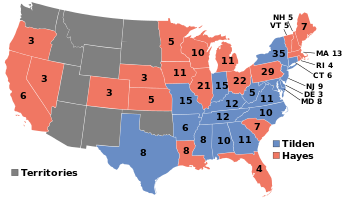
Back انتخابات الرئاسة الأمريكية 1876 Arabic Præsidentvalget i USA 1876 Danish Präsidentschaftswahl in den Vereinigten Staaten 1876 German Elecciones presidenciales de Estados Unidos de 1876 Spanish Yhdysvaltain presidentinvaalit 1876 Finnish Élection présidentielle américaine de 1876 French הבחירות לנשיאות ארצות הברית 1876 HE Elezioni presidenziali negli Stati Uniti d'America del 1876 Italian 1876年アメリカ合衆国大統領選挙 Japanese 1876년 미국 대통령 선거 Korean
| |||||||||||||||||||||||||||||
369 members of the Electoral College 185 electoral votes needed to win | |||||||||||||||||||||||||||||
|---|---|---|---|---|---|---|---|---|---|---|---|---|---|---|---|---|---|---|---|---|---|---|---|---|---|---|---|---|---|
| Turnout | 82.6%[1] | ||||||||||||||||||||||||||||
| |||||||||||||||||||||||||||||
 Presidential election results map. Red denotes states won by Hayes/Wheeler, blue denotes those won by Tilden/Hendricks. Numbers indicate the number of electoral votes allotted to each state. | |||||||||||||||||||||||||||||
| |||||||||||||||||||||||||||||
The 1876 United States presidential election was the 23rd quadrennial presidential election, held on Tuesday, November 7, 1876. Incumbent Republican president Ulysses S. Grant declined to run for a third term, so the party chose Rutherford B. Hayes, the governor of Ohio, as its nominee. The Democratic Party nominated New York governor Samuel J. Tilden as their nominee. It was one of the most contentious presidential elections in American history. Its resolution involved negotiations between the Republicans and Democrats, resulting in the Compromise of 1877, and on March 2, 1877, the counting of electoral votes by the House and Senate occurred, confirming Hayes as president. It was the second of five U.S. presidential elections in which the winner did not win a plurality of the national popular vote. This is the first time it happened since 1824. Following President Grant's decision to retire after his second term, U.S. Representative James G. Blaine emerged as the frontrunner for the Republican nomination. However, Blaine was unable to win a majority at the 1876 Republican National Convention, which settled on Governor Hayes of Ohio as a compromise candidate. The 1876 Democratic National Convention nominated Governor Tilden of New York on the second ballot.
The results of the election remain among the most disputed ever. Although it is not disputed that Tilden beat Hayes in the popular vote, there were wide allegations of electoral fraud, election violence, and disfranchisement of (predominantly Republican) black voters. After a first count of votes, Tilden won 184 electoral votes to Hayes's 165 with 20 votes from Florida, Louisiana, South Carolina, and Oregon unresolved. To address the resulting constitutional crisis, Congress established the Electoral Commission, a majority of which were Republicans, which awarded all twenty votes (and thus the presidency) to Hayes. Some Democratic representatives filibustered the commission's decision, hoping to prevent Hayes's inauguration, but their filibuster was ultimately ended by party leader Samuel J. Randall. The question of who should have been awarded those electoral votes is the source of the continued controversy, and historians attribute Randall's decision to drop the filibuster to the informal Compromise of 1877.[2]
To date, it remains the election that yielded the highest voter turnout of the eligible voting-age population in American history, at 82.6%.[3][4] Tilden's 50.9% is the largest share of the popular vote received by a candidate who was not elected to the presidency. Tilden was also the last person to win a majority of the popular vote until William McKinley in 1896. As of 2024[update], this marks the only presidential election in which both candidates were sitting governors.
- ^ "National General Election VEP Turnout Rates, 1789–Present". United States Election Project. CQ Press.
- ^ "NCpedia | NCpedia". www.ncpedia.org. Retrieved June 22, 2023.
- ^ Between 1828–1928: "Voter Turnout in Presidential Elections: 1828–2008". The American Presidency Project. University of California, Santa Barbara. Retrieved November 9, 2012.
- ^ Between 1932 and 2008: "Table 397. Participation in Elections for President and U.S. Representatives: 1932 to 2010" (PDF). U.S. Census Bureau, Statistical Abstract of the United States: 2012. U.S. Census Bureau. Archived from the original (PDF) on October 24, 2012. Retrieved February 7, 2013.
© MMXXIII Rich X Search. We shall prevail. All rights reserved. Rich X Search

